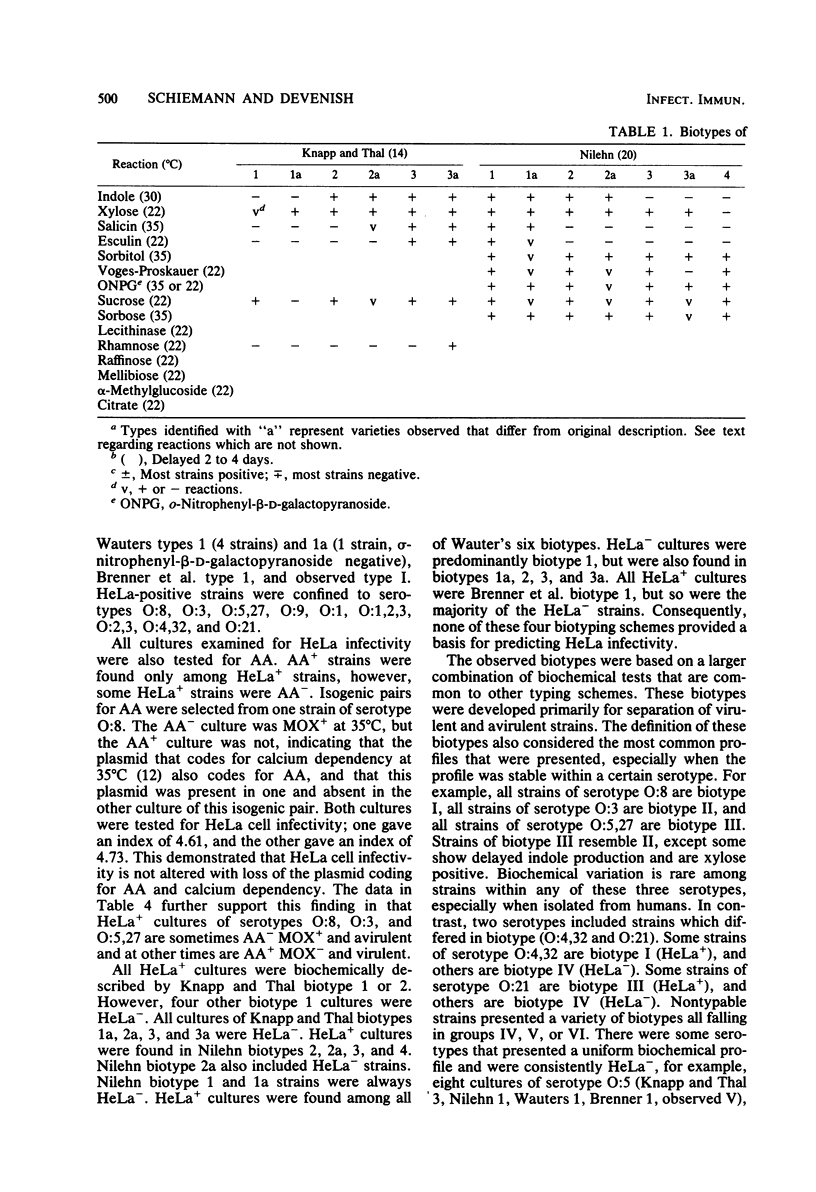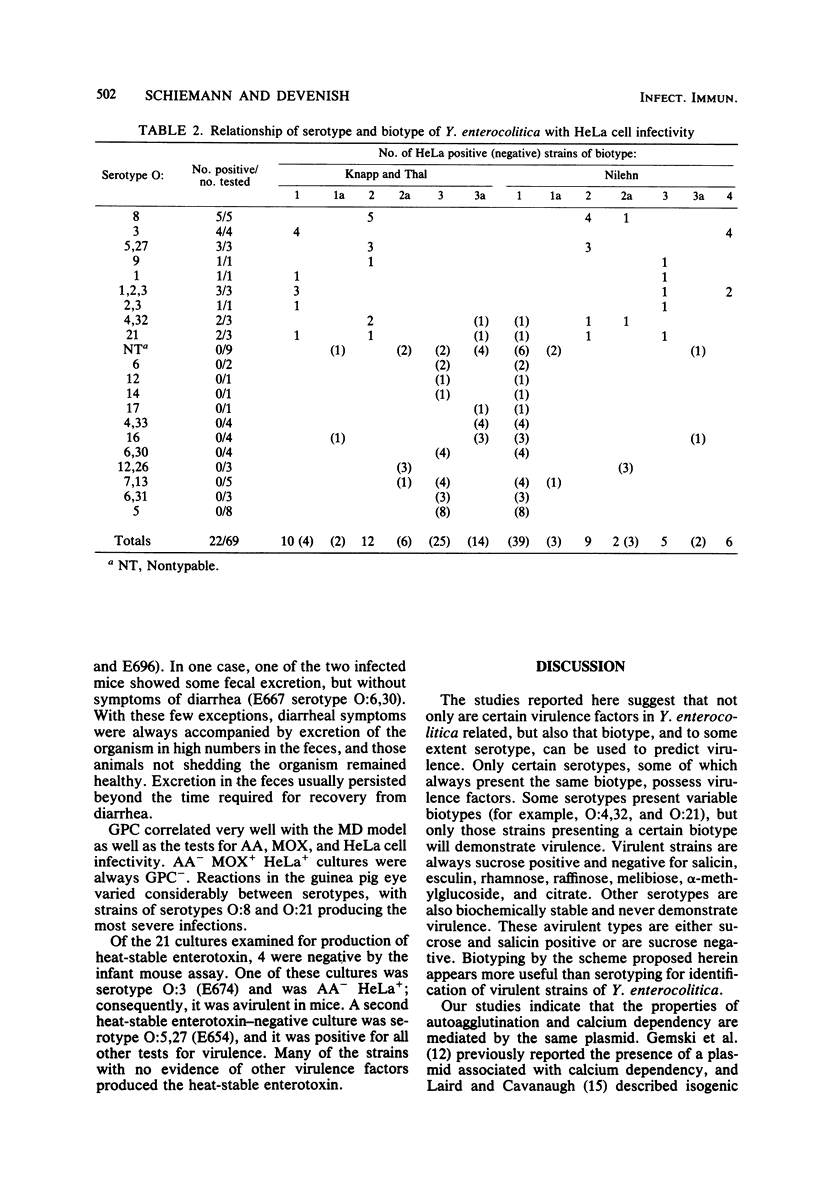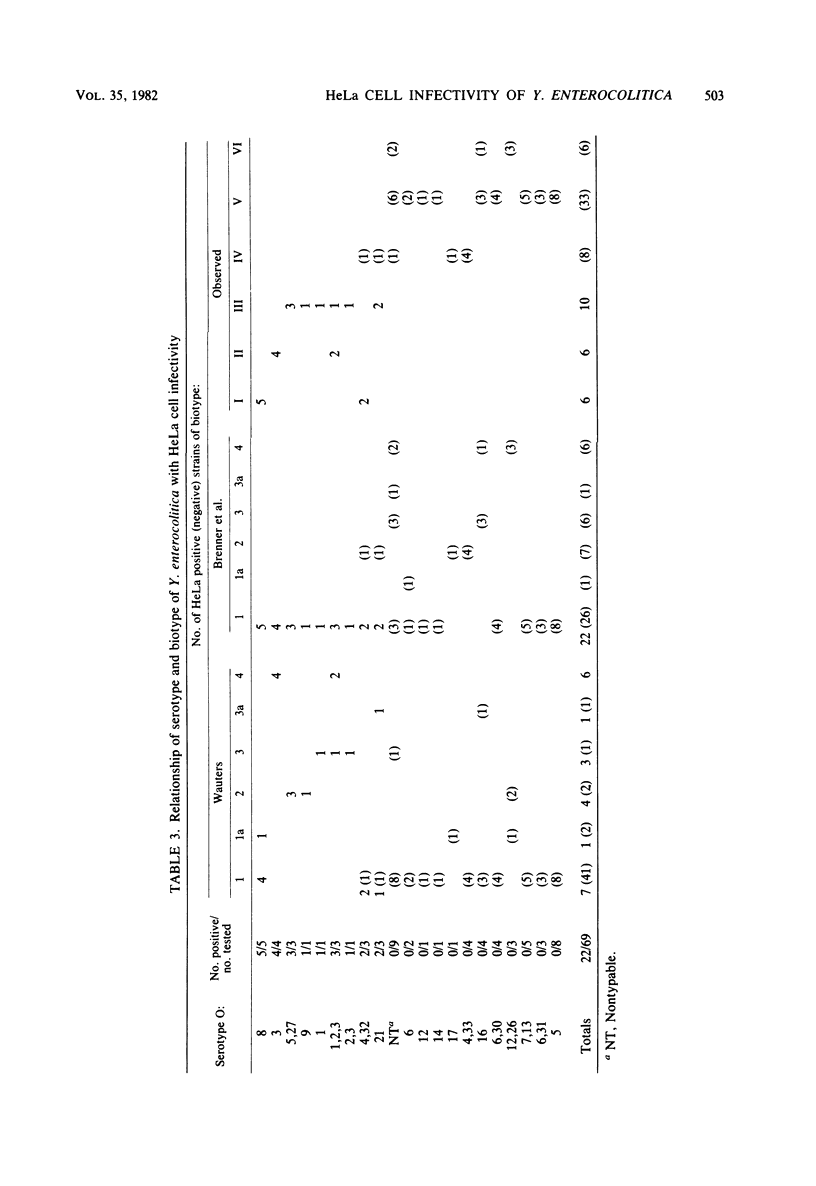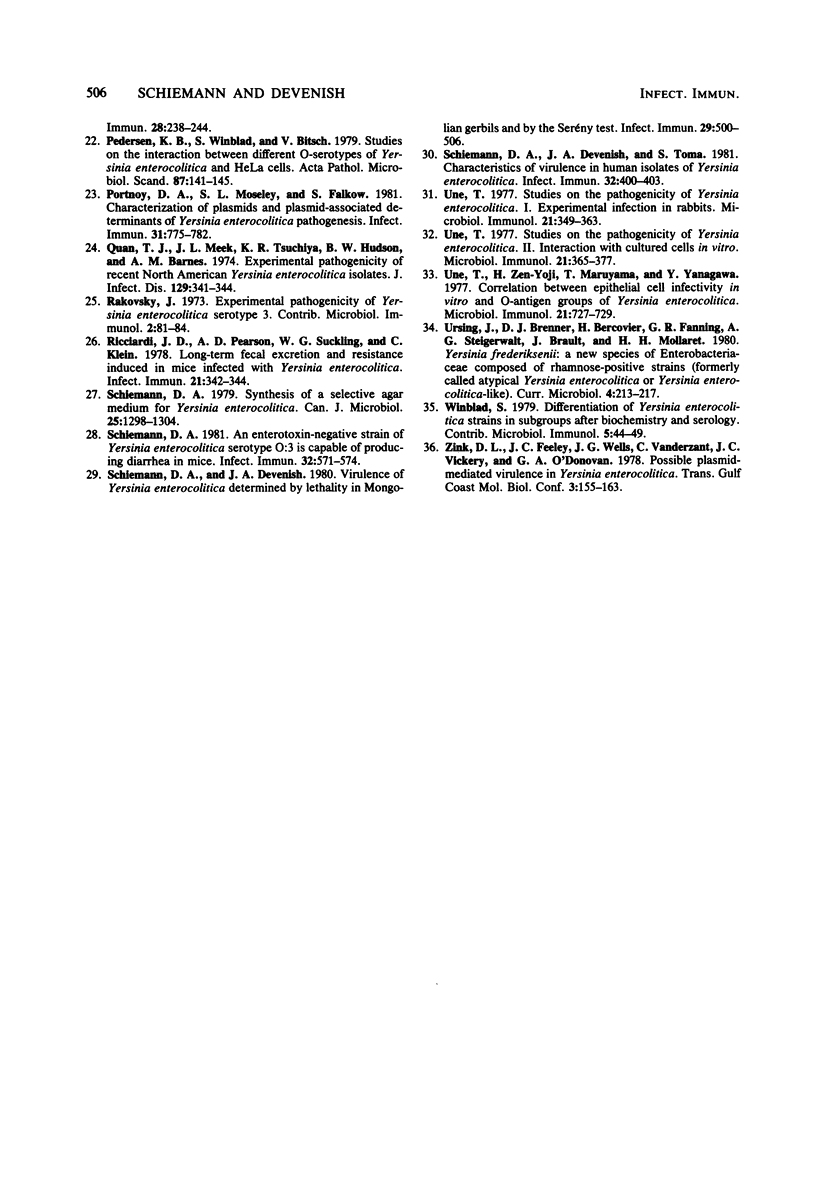Abstract
Examination of 69 strains of Yersinia enterocolitica which represented 20 serotypes and nontypable isolates for HeLa cell infectivity by a roller tube technique that provided a quantitative index of infection showed that infectivity (index, greater than 3.50) was confined to strains of serotypes O:8, O:3, O:5, 27, O:9, O:1, O:1,2,3, O:2,3, O:4,32, and O:21. All strains that were HeLa positive were sucrose positive and negative for salicin, esculin, rhamnose, raffinose, melibiose, alpha-methylglucoside, and citrate. All HeLa-negative strains were either sucrose and salicin positive or were sucrose negative. Twenty-one strains were examined for virulence by the ability to produce guinea pig conjunctivitis and diarrhea in mice. Positive strains were limited to those that were HeLa positive and were autoagglutination positive and calcium dependent at 35 degrees C. There was no association between virulence and the ability to produce enterotoxin measured by the infant mouse assay. Loss of autoagglutinability and calcium dependency was accompanied by loss of virulence, but HeLa cell infectivity was unchanged. The results suggest that at least two properties are necessary for virulence: the presence of the V and W antigens, mediated by the same plasmid as autoagglutination and calcium dependency, and an invasive factor demonstrated in vitro by HeLa cell infectivity. These virulence properties are found in only certain biotypes of Y. enterocolitica.
Full text
PDF









Selected References
These references are in PubMed. This may not be the complete list of references from this article.
- Alonso J. M., Bercovier H., Destombes P., Mollaret H. H. Pouvoir pathogène expérimental de Yersinia enterocolitica chez la souris athymique (nude) Ann Microbiol (Paris) 1975 Sep;126(2):187–199. [PubMed] [Google Scholar]
- Brenner D. J. Speciation in Yersinia. Contrib Microbiol Immunol. 1979;5:33–43. [PubMed] [Google Scholar]
- Carter P. B., Varga C. F., Keet E. E. New strain of Yersinia enterocolitica pathogenic for rodents. Appl Microbiol. 1973 Dec;26(6):1016–1018. doi: 10.1128/am.26.6.1016-1018.1973. [DOI] [PMC free article] [PubMed] [Google Scholar]
- Carter P. B., Zahorchak R. J., Brubaker R. R. Plague virulence antigens from Yersinia enterocolitica. Infect Immun. 1980 May;28(2):638–640. doi: 10.1128/iai.28.2.638-640.1980. [DOI] [PMC free article] [PubMed] [Google Scholar]
- Devenish J. A., Schiemann D. A. HeLa cell infection by Yersinia enterocolitica: evidence for lack of intracellular multiplication and development of a new procedure for quantitative expression of infectivity. Infect Immun. 1981 Apr;32(1):48–55. doi: 10.1128/iai.32.1.48-55.1981. [DOI] [PMC free article] [PubMed] [Google Scholar]
- Gemski P., Lazere J. R., Casey T. Plasmid associated with pathogenicity and calcium dependency of Yersinia enterocolitica. Infect Immun. 1980 Feb;27(2):682–685. doi: 10.1128/iai.27.2.682-685.1980. [DOI] [PMC free article] [PubMed] [Google Scholar]
- Laird W. J., Cavanaugh D. C. Correlation of autoagglutination and virulence of yersiniae. J Clin Microbiol. 1980 Apr;11(4):430–432. doi: 10.1128/jcm.11.4.430-432.1980. [DOI] [PMC free article] [PubMed] [Google Scholar]
- Lee W. H., McGrath P. P., Carter P. H., Eide E. L. The ability of some Yersinia enterocolitica strains to invade HeLa cells. Can J Microbiol. 1977 Dec;23(12):1714–1722. doi: 10.1139/m77-247. [DOI] [PubMed] [Google Scholar]
- Maruyama T., Une T., Zen-Yoji H. Observations on the correlation between pathogenicity and serovars of Yersinia enterocolitica by the assay applying cell culture system and experimental mouse infection. Contrib Microbiol Immunol. 1979;5:317–323. [PubMed] [Google Scholar]
- Maruyama T. [Biological characteristics and pathogenicity of Yersinia enterocolitica. 2. Experimental infection in monkeys and pathological observation]. Nihon Saikingaku Zasshi. 1973 Sep;28(5):413–421. [PubMed] [Google Scholar]
- Mollaret H. H., Guillon J. C. Contribution à l'étude d'un nouveau groupe de germes (Yersinia enterocolitica) proches du bacille de Malassez et Vignal. II. Pouvoir pathogène expérimental. Ann Inst Pasteur (Paris) 1965 Oct;109(4):608–613. [PubMed] [Google Scholar]
- Pedersen K. B., Winblad S., Bitsch V. Studies on the interaction between different O-serotypes of Yersinia enterocolitica and HeLa cells. Acta Pathol Microbiol Scand B. 1979 Apr;87B(2):141–145. doi: 10.1111/j.1699-0463.1979.tb02417.x. [DOI] [PubMed] [Google Scholar]
- Portnoy D. A., Moseley S. L., Falkow S. Characterization of plasmids and plasmid-associated determinants of Yersinia enterocolitica pathogenesis. Infect Immun. 1981 Feb;31(2):775–782. doi: 10.1128/iai.31.2.775-782.1981. [DOI] [PMC free article] [PubMed] [Google Scholar]
- Quan T. J., Meek J. L., Tsuchiya K. R., Hudson B. W., Barnes A. M. Experimental pathogenicity of recent North American isolates of Yersinia enterocolitica. J Infect Dis. 1974 Mar;129(3):341–344. doi: 10.1093/infdis/129.3.341. [DOI] [PubMed] [Google Scholar]
- Ricciardi I. D., Pearson A. D., Suckling W. G., Klein C. Long-term fecal excretion and resistance induced in mice infected with Yersinia enterocolitica. Infect Immun. 1978 Jul;21(1):342–344. doi: 10.1128/iai.21.1.342-344.1978. [DOI] [PMC free article] [PubMed] [Google Scholar]
- Schiemann D. A. An enterotoxin-negative strain of Yersinia enterocolitica serotype O:3 is capable of producing diarrhea in mice. Infect Immun. 1981 May;32(2):571–574. doi: 10.1128/iai.32.2.571-574.1981. [DOI] [PMC free article] [PubMed] [Google Scholar]
- Schiemann D. A., Devenish J. A., Toma S. Characteristics of virulence in human isolates of Yersinia enterocolitica. Infect Immun. 1981 Apr;32(1):400–403. doi: 10.1128/iai.32.1.400-403.1981. [DOI] [PMC free article] [PubMed] [Google Scholar]
- Schiemann D. A., Devenish J. A. Virulence of Yersinia enterocolitica determined by lethality in Mongolian gerbils and by the Serény test. Infect Immun. 1980 Aug;29(2):500–506. doi: 10.1128/iai.29.2.500-506.1980. [DOI] [PMC free article] [PubMed] [Google Scholar]
- Schiemann D. A. Synthesis of a selective agar medium for Yersinia enterocolitica. Can J Microbiol. 1979 Nov;25(11):1298–1304. doi: 10.1139/m79-205. [DOI] [PubMed] [Google Scholar]
- Une T. Studies on the pathogenicity of Yersinia enterocolitica. I. Experimental infection in rabbits. Microbiol Immunol. 1977;21(7):341–363. [PubMed] [Google Scholar]
- Une T. Studies on the pathogenicity of Yersinia enterocolitica. II. Interaction with cultured cells in vitro. Microbiol Immunol. 1977;21(7):365–377. doi: 10.1111/j.1348-0421.1977.tb00301.x. [DOI] [PubMed] [Google Scholar]
- Une T., Zen-Yoji H., Maruyama T., Yanagawa Y. Correlation between epithelial cell infectivity in vitro and O-antigen groups of Yersinia enterocolitica. Microbiol Immunol. 1977;21(12):727–729. doi: 10.1111/j.1348-0421.1977.tb00340.x. [DOI] [PubMed] [Google Scholar]
- Winblad S. Differentiation of Yersinia enterocolitica strains in subgroups after biochemistry and serology. Contrib Microbiol Immunol. 1979;5:44–49. [PubMed] [Google Scholar]


